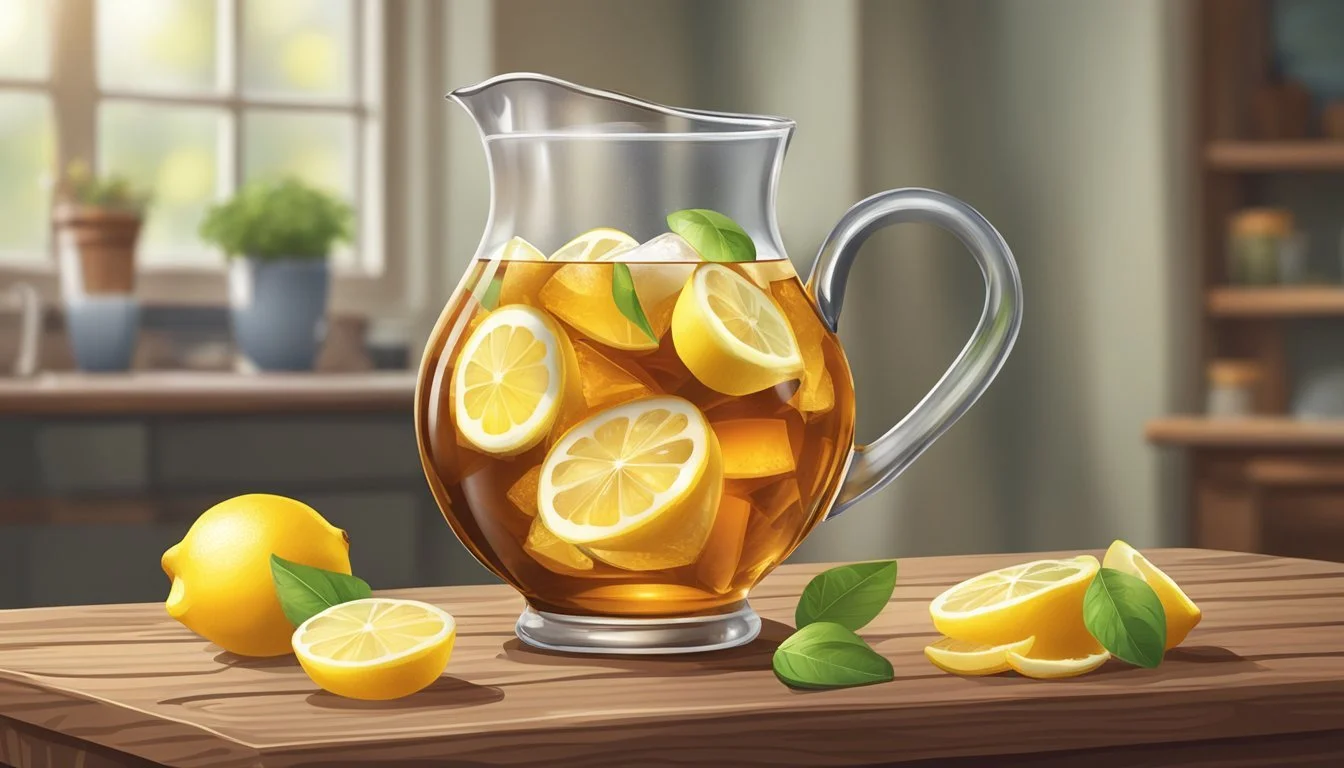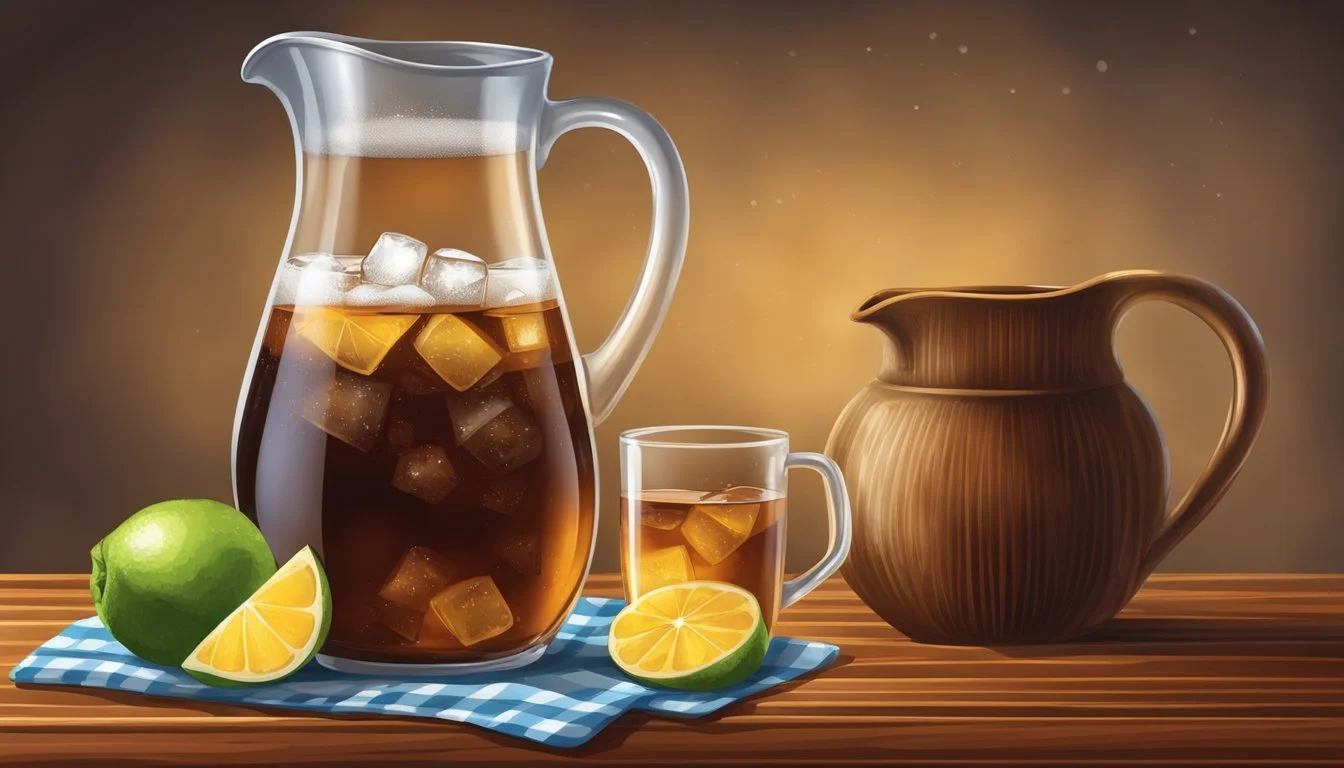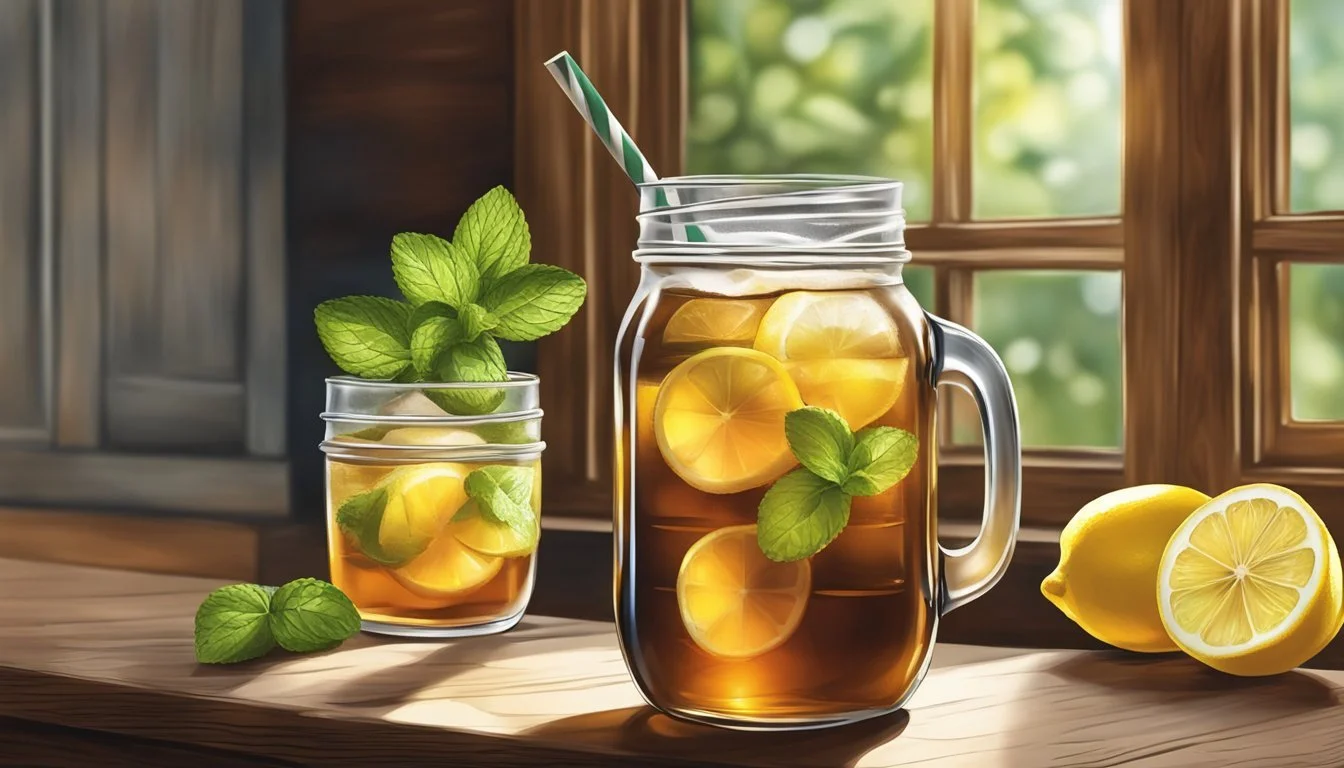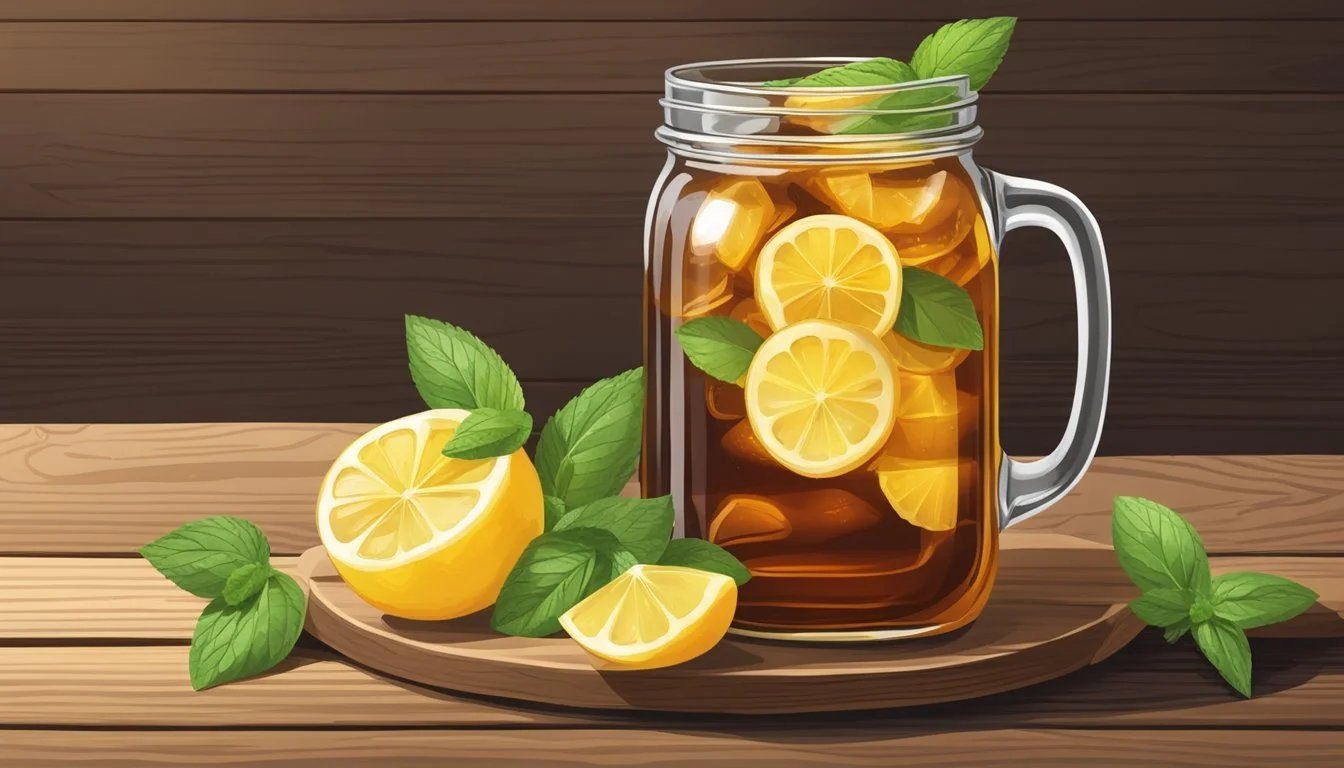Texas Sweet Tea
A Refreshing Staple of Southern Hospitality
Sweet tea is an iconic beverage deeply woven into the fabric of Texas social life, symbolizing Southern hospitality and comfort. Originating in the Southern United States, this sweetened version of iced tea has permeated Texan culture, where it is often referred to as the "Southern champagne." Brewed in large batches, it is sweetened while still hot to ensure the sugar (how long does sugar last?) dissolves completely, creating a smooth and rich flavor that is then chilled to perfection.
In Texas, the nuances of sweet tea preparation are treated with a kind of reverence; the process is straightforward but requires a precise balance of time, temperature, and proportion of ingredients. Texans prefer their sweet tea made with high-quality black tea and the sweetness level can vary according to personal taste, but it is typically more sweet than not. The result is a refreshing drink that is always ready to serve, whether it's for an unexpected guest or a family gathering on a hot summer day.
Sweet tea in Texas is not merely a thirst-quencher; it's a cultural staple. It is commonly served at restaurants and drive-throughs and is a fixture at picnics and barbecues. The beverage's consistent popularity has made it a topic of friendly debate, with many individuals and establishments claiming to have the best recipe. Recipe variations might include a pinch of baking soda (how long does baking soda last?) to ensure clarity and smoothness, but the core components of this beloved Texan standby remain the same: black tea, water, and plenty of sugar.
Origins of Sweet Tea
Sweet tea's role as a beloved beverage in the South gives it a cultural significance extending beyond refreshment. Tracing the origins of sweet tea via iced tea reveals its deep ties to Southern tradition and its nuance in Texas.
History of Sweet Tea
The tradition of iced sweet tea began taking shape in the United States towards the end of the 19th century, where it was made as made with sweet, unsweetened tea or unsweetened iced tea. Originally, sweet tea was not a Southern exclusive; it arrived in America from far-off lands such as China. The American South largely embraced the beverage by adding ample sugar to the iced tea, creating what is now known as sweet tea. It became a popular habit to drink sweet tea and the sweet version became a symbol of Southern hospitality and warmth.
The sweet tea prepared in the South generally involves brewing black tea and sweetening it while hot. Sweetness levels may vary, but it is typically served over ice and often garnished with a slice of lemon.
Texas Sweet Tea
In Texas, sweet tea is not only a refreshing beverage but also a cultural marker. It stands at the intersection of the state's culinary influences and Southern tradition. Texas sweet tea often reflects the character of East Texas, which closely aligns with Deep South culture.
Availability: One can find sweet tea ubiquitously across Texas, often in every restaurant and home.
Cultural Significance: It reinforces regional identity, especially in East Texas, cementing its connection with Southern roots.
Texas's adaptation of sweet tea fits into a broader regional affection for the drink. Over time, this simple yet distinct beverage has woven itself into the fabric of Texas culture just as it has in the rest of the South.
Tea Basics
When crafting the quintessential Sweet Tea, one must understand the tea fundamentals that serve as its foundation. The quality and type of tea used are paramount in achieving the desired flavor and strength suitable for this Southern favorite.
Types of Tea
Black Tea: A common choice for sweet tea, black tea is fully oxidized, which imparts a bold and robust flavor, making it an ideal base for sweetening. It is the traditional choice for Southern sweet tea due to its full-bodied taste. Black tea is made from the leaves of a bush called Camellia sinensis and the leaves turn from green to black as they oxidize in the air. This creates the tea flavor needed to make Southern sweet tea.
Green Tea: Less oxidized than black tea, green tea offers a milder flavor and a lighter color. While not typically used for classic sweet tea, its subtle taste provides a refreshing alternative for those seeking a less intense tea experience.
When preparing sweet tea, the steeping time for the hot tea varies according to individual preference, with some opting for a brief steep to achieve a lighter flavor, while others prefer a brewed tea that is steeped for longer.
Preparing the Base
Perfecting Texas sweet tea begins with a solid foundation: the tea and the water used to brew it. These two elements are crucial for a refreshing and authentic sweet tea experience.
Selecting Quality Tea Bags
One must be discerning when choosing Texas sweet tea bags (how long do tea bags last?). Black tea or organic black tea is typically used for its robust flavor and classic taste. The strength of the tea bag can vary with the quantity, where usually, 4 to 6 tea bags per gallon of water is a standard starting point.
Make your life easier by ordering black tea online; it's just a few clicks away!
The Importance of Water
The water quality cannot be overstated in the tea-making process. While tap water is commonly used, filtered water is advisable for ensuring a clear flavor profile that doesn't compete with the tea. A gallon of water is brought to a near boil, ensuring it's hot enough to steep the tea bags properly.
Sweetening Techniques
The sweetening method is as important as the tea itself to craft a delightful Texas sweet tea. Two effective techniques assure a balanced and fully integrated sweetness: creating a simple syrup and selecting the right sugar.
Creating Simple Syrup
One can create simple syrup by gently heating water and sugar in equal parts until the sugar dissolves. This liquid sweetener blends seamlessly with the tea, ensuring no granules settle at the bottom of the glass. A rich simple syrup can be made with cane sugar for Texas sweet tea, enhancing the drink with a slight molasses (how long does molasses last?) note.
Choosing the Right Sugar
The choice of sugar impacts the final taste of the tea, so it's best to avoid high fructose corn syrup (how long does corn syrup last?). Granulated sugar is the standard, but one might consider using cane sugar for a deeper sweetness. Its subtle caramel-like flavor complements the robustness of black tea. The table below outlines sugar options:
Sugar Type Characteristics Sweetening Power Granulated Sugar Clean, neutral sweetness Standard Cane Sugar Rich flavor with a hint of molasses Slightly stronger
Avoid the crowds and shop for cane sugar online from the comfort of your home!
Brewing and Steeping
In crafting Texas sweet tea, the subtleties of steeping and precise brewing times are pivotal for achieving the desired balance of flavors.
Essentials of Steeping
Steeping is a process where the black tea or organic black tea is soaked in water to extract flavors and compounds. It's essential to start with boiling water to fully extract the tea's flavors from the hot tea, which include the natural tannins that contribute to the tea’s characteristic taste. For optimal steeping, one should:
Bring half a gallon of water to a full boil.
Remove from heat before adding tea leaves.
Agitate the boiling water for 30 seconds to ensure the tea leaves are fully immersed and beginning to release their flavors.
Optimal Brewing Times
The duration the tea bags spend in the boiling water is critical. Too long, and the tannins become over-extracted, leading to bitterness. It is too short, and the tea may be underwhelming in flavor. Add any additional flavors to steep, such as cinnamon stick. The recommended steps are:
Steep the tea leaves for 4 1/2 minutes.
After steeping, remove the tea leaves promptly to prevent over-extraction.
By adhering to the right steeping practices and brewing times, one ensures a perfectly balanced sweet tea, capturing the essence of Texas hospitality.
Cooling and Serving
When preparing Texas sweet tea, the cooling phase is crucial for achieving the right temperature and flavor. A properly chilled tea maximizes refreshment, particularly on a hot day.
How to Chill
After steeping and sweetening the tea, the next critical step is to cool it effectively without diluting the flavor. The ideal approach involves storing the tea in the fridge rather than adding ice immediately. This allows the tea to chill evenly and reduces the risk of over-dilution. It's advised to:
Pour the sweet tea into a pitcher.
Let the tea come to room temperature, which prevents the fridge from working harder than needed.
Refrigerate the pitcher, allowing the tea to cool for at least 2 hours.
Experience the convenience and savings of buying a pitcher, online!
Serving Suggestions
Once the tea is sufficiently chilled, it's time to serve it in a way that enhances the enjoyment. For serving:
Fill a tall glass with ice cubes to keep the tea cold without quickly watering it down.
Pour the chilled tea over the ice cubes to refresh and cool the drink instantly.
Optionally, garnish with a slice of lemon or a sprig of mint for an aromatic touch.
Using a glass pitcher can also add visual appeal, showcasing the rich color of the tea, enhancing the serving experience.
Enhancing Flavor
Crafting the perfect Texas sweet tea involves more than just mixing tea and sugar. It's about layering flavors to create a refreshing and aromatic experience. Citrus and herbs play a crucial role in elevating the taste of this beloved Southern beverage.
Infusing with Citrus
Adding citrus to sweet tea imparts a tangy zest that can complement the sweetness of the sugar. Here are specific ways to enhance your tea with citrus:
Lemon: Squeeze the juice of a fresh lemon directly into the tea or add slices to the pitcher. Lemon not only provides a bright hit of acidity but also adds a solar burst of Vitamin C to the drink.
Orange: For a different twist, infuse the tea with orange slices. The subtler, sweeter citrus note of orange can bring a delightful complexity to the classic tea flavor profile.
Adding Herbal Notes
Herbs offer a fresh, aromatic quality that can beautifully counterbalance the sweetness of tea. Consider these options:
Mint: Incorporating mint into sweet tea gives it a crisp and refreshing edge. Fresh mint sprigs can be muddled to release their essential oils before being stirred into the tea.
Mint Sprigs for Garnish: Use whole mint sprigs as a garnish for an elegant and aromatic touch. It's not only visually appealing but also provides a fragrant hint with every sip.
Sweet Tea Variations
Sweet tea, particularly the Texas variety, is renowned for its rich, sugary flavor, often seen as a hallmark of Southern hospitality. This section explores different regional takes on the classic beverage and inventive modern adaptations that add a new twist to tradition.
Regional Variations
The Southern United States is home to a plethora of sweet tea variations, each state adding its local flair. In South Carolina and parts of Georgia, tea is often brewed strong and sweetened with ample sugar, sometimes garnished with a slice of lemon. Moving to Virginia, sweet tea may be slightly less sweet, maintaining the refreshing taste perfect for hot summer days.
Florida adds to the spectrum by infusing tropical flavors, such as orange or mango, reflecting its citrus heritage. Meanwhile, Texas sweet tea stands apart with a bolder taste, often served with a hearty helping of ice, keeping it cool against the sweltering heat.
Contemporary Twists
Contemporary updates to sweet tea often involve incorporating unique ingredients or combining existing beverage traditions.
Arnold Palmer: A classic example is the Arnold Palmer, a refreshing mix of sweet tea and lemonade. Started as a golfer's refreshment, it has gained widespread popularity across the United States.
Fruit-Infused Teas: Modern variations sometimes include fruit-infused teas, adding layers of flavor - peach and raspberry are particularly popular.
Spiked Sweet Teas: For adults, there's a rising trend in spiked sweet teas, where the tea is fortified with spirits such as bourbon or vodka, bringing a spirited twist to gatherings.
Each contemporary twist provides a unique tasting experience, reflecting the dynamic nature of this beloved Southern staple.
Sweet Tea in Food Culture
Sweet tea, a beverage deeply embedded in Texas traditions, complements a myriad of dining experiences and has permeated various forms of media, reflecting its significance in the food culture.
Pairing with Meals
Sweet tea serves as the quintessential drink alongside Southern meals. Dinner in Texas often welcomes this sugary refreshment, which graces the tables of fast food joints and family homes. Sweet tea is especially prominent at popular fast food chains like McDonald’s, Chick-fil-A, and Zaxby’s, where it maintains a steadfast presence on the menu. Its role is not only as a standalone beverage but as a versatile companion to standards, whether it be a barbecue brisket or a summer garden salad.
Representation in Media
In media, sweet tea is frequently depicted as a symbol of Southern hospitality and tradition. Its portrayal ranges from social media platforms like Facebook, where individuals and groups may share sweet tea recipes and anecdotes, to popular films and television shows where a glass of sweet tea is synonymous with a warm welcome. Even in a world where wine and cocktails may dominate the culinary scene, sweet tea stands out in Texan media for its cultural authenticity and unpretentious roots.
Practical Tips
When preparing Texas sweet tea, planning for quantity and storage ensures you always have this refreshing beverage. Accurate measurements and appropriate containers play crucial roles in the process.
Making Large Batches
For those hosting gatherings or simply wanting to enjoy sweet tea throughout the week, making large batches is practical. Start by boiling half a gallon of filtered water—this is enough for a standard pitcher. After removing from the heat, steep the tea bags for about 4 to 5 minutes; this ensures a robust flavor without bitterness. Dissolving three-quarters of a cup of sugar into the hot water ensures a consistent sweetness for sweetening. Once cooled, add five cups of cold water, diluting the tea to the right strength, and chill it for immediate enjoyment.
Storage Advice
Proper storage is vital to maintain the freshness of sweet tea. Ensure the tea is completely cooled before transferring it to a pitcher for refrigeration. Sweet tea is best enjoyed within 48 hours to preserve its optimal taste, although it can be kept for up to one week when stored correctly. Use a glass pitcher with a tight-sealing lid to protect the flavor, and always refrigerate promptly after serving to prevent spoilage. If brewing sun tea, remember the process is slower, and it's crucial to monitor the steeping time to avoid a diluted taste.
Health and Nutrition
Texas sweet tea is a staple in Southern cuisine known for its refreshing taste. However, health and nutrition are important considerations when consuming this beverage, particularly regarding its sugar content and potential alternatives for sweetening.
Sugar Content
Texas sweet tea traditionally contains significant sugar, contributing to its distinctive sweetness.
Typical Sugar Content per 12 fl oz Serving:
Calories: 100
Total Fat: 0g
Saturated Fat: 0g
Trans Fat: 0g
Cholesterol: 0mg
Sodium: (not specified in the snippets)
Total Sugars: (not specified in the snippets)
The consumption of sweetened beverages like Texas sweet tea can lead to an increased intake of calories, primarily through sugars such as cane sugar. Regularly consuming high-sugar drinks may contribute to weight gain and associated health issues if not balanced with physical activity and a controlled diet.
Alternatives for Sweetening
For those seeking to reduce sugar intake, there are alternatives to sweeten Texas sweet tea without relying solely on cane sugar:
Natural Sweeteners: Options such as stevia contain fewer calories.
Artificial Sweeteners: Such as aspartame or sucralose, though they may have an aftertaste that differs from sugar.
It is important to consider that while these alternatives may offer a lower calorie count, consumers should research and understand the different profiles and effects of these sweeteners, and choose based on dietary needs and personal taste preference.
DIY Sweet Tea
Making sweet tea at home is a delightful practice, blending simplicity and tradition to create the quintessential summer beverage. Whether you're a novice or an experienced tea brewer, the process is approachable, with plenty of room for personalization.
Homemade Sweet Tea Recipes
A basic sweet tea recipe involves just a few steps:
Heat Water: Bring a pot of water (about half a gallon) to a near boil.
Steep: Remove the boiling water from the heat. Steep the tea bags or loose leaves for 5 to 15 minutes.
Dissolve Sugar: While the tea is hot, add sugar to your taste and stir until fully dissolved.
Combine and Chill: Pour the sweetened tea into a pitcher, add cold water to the desired strength, and refrigerate until cool.
Housekeeping in Old Virginia provides a historic and authentic touch to this refreshing drink, often featuring a recipe that has been passed down through generations.
Customization and Experimentation
Sweet tea offers a canvas for customization, with variations ranging from the tea choice to the sweetness level and additional flavorings.
Tea Selection: Black tea is traditional, but one may also use green, white, or herbal teas.
Sweetness: Adjust sugar to preferred sweetness; some may like to start with ¾ cup per gallon of tea and adjust from there.
Flavor Additions: Lemon, mint, or peach slices are popular additions.
Experimentation allows for a unique take on this classic drink that can be tailored to personal preferences or the mood of summer gatherings.











